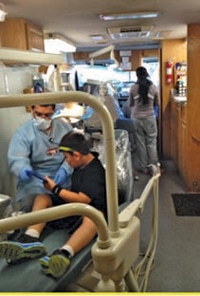
Dental Care on the Go
The University of southern california Ostrow school of Dentistry runs two mobile dental clinics dedicated entirely to providing preventive services for lowincome children.
In 2000, the United States Surgeon General David Satcher, MD, PhD, FAAFP, FACPM, FACP, highlighted the fact that people with special needs were severely underserved and experienced profound oral health disparities.1 Other populations with underserved dental needs include families living below the federal poverty line, individuals with medical disabilities or chronic illness, patients who live in geographically isolated locations, those with low literacy, and individuals living in long-term care facilities (LTCFs). In 2011, the Institute of Medicine published “Improving Access to Oral Health Care for Vulnerable and Underserved Populations,” which indicated that these disparities in access to oral health care still exist and continue to grow.2

What is being done about these disparities? In many states, efforts are underway to provide dental hygienists with more autonomy to practice at the fullest extent of their education and expertise—enabling them to reach underserved patients. The creation of mid-level providers who can treat patients in alternative environments has also helped to alleviate access-to-care problems. Mobile dentistry has evolved to become an alternative practice setting. The use of mobile clinics to reach populations that have difficulty accessing oral care—either due to distance or lack of transportation—is growing. Dental vans may be driven to LTCFs to provide services to older adults with comorbidities or visit schools in small towns to provide preventive and restorative services.
DENTAL HYGIENE CLINICS GO MOBILE

The Community Oral Health Programs at the Ostrow School of Dentistry at the University of Southern California (USC) in Los Angeles have several avenues to address the dental needs of underserved populations. Clinicians aboard the school’s mobile clinics drive long distances to treat patients in rural areas. This program is supervised by USC dental faculty, and dental and dental hygiene students provide care. Five years ago, Avishai Sadan, DMD, dean of the dental school, donated two recreational vehicles to the Department of Dental Hygiene for the exclusive provision of preventive treatments (Figure 1). Since then, the mobile clinics have allowed clinicians to visit hundreds of children at inner city schools in Los Angeles, enabling dental hygienists to place sealants and apply fluoride treatments, provide oral hygiene and nutritional education, and dispense kits containing oral health supplies (Figure 2).
The protocol for the mobile dental clinics begins with a USC representative contacting a school and collaborating with the principal, nurse, and a facilitator. Consent forms and a brochure describing the program, called the Neighborhood Mobile Dental Van Prevention Program, are sent home to families with students ranging from prekindergarten to third grade. These services are provided at no cost to the family. During the first phase, children’s height and weight are recorded and their teeth are screened by faculty pediatric dentists. If a parent/caregiver gives consent, then digital radiographs are taken and scanned in the dental van by dental hygiene students. These radiographs are forwarded electronically for review by dental faculty. If caries lesions are detected, the child’s parent/caregiver is contacted. The parent/caregiver may take the child to his/her own dentist or bring the child to the dental school’s pediatric clinic. For children without insurance coverage, a $100 voucher is given to visit the dental school. During phase two, dental hygiene students use a laser caries detection device and an intraoral camera to document oral health status. The data are sent to a faculty dentist who reviews the records. The dental hygiene student then provides oral hygiene and nutritional education, sealant placement, prophylaxis, and fluoride varnish application. Once the radiographs have been read and digital photos and scores from the laser detection device are reviewed, the dentist provides a treatment plan to the dental hygienists in the van. Follow-up by the directors of the program ensure that children receive treatment for caries.
This mobile model of preventive care for school children is sustainable in California if practicing dental hygienists earn their alternative practice license. Registered dental hygienists in alternative practice (RDHAP) are given provider numbers so they can bill dental insurance companies or California’s public dental care plan. RDHAPs need to partner with a dentist to diagnose patients and plan treatment. California legislation (AB 1174) was recently signed into law, making this model a viable way to provide dental services to children.
REFERENCES
- Satcher DS. Surgeon General’s report on oral health. Public Health Rep. 2000;115:489–490.
- Institute of Medicine. Improving Access to Oral Health Care for Vulnerable and Underserved Populations. Available at: iom.edu/Reports/2011/Improving-Accessto- Oral-Health-Care-for-Vulnerable-and-Underserved-Populations.aspx. Accessed September 24, 2014.
From Perspectives on Dental Hygiene, a supplement to Dimensions of Dental Hygiene. November 2014;12(11):42–43.

